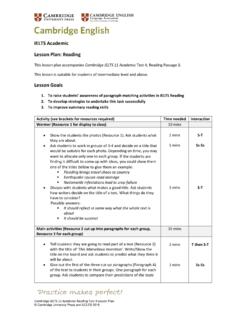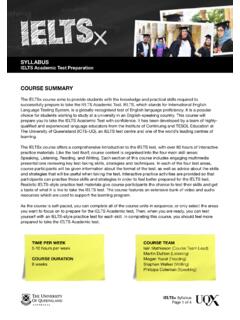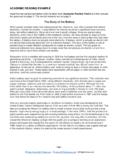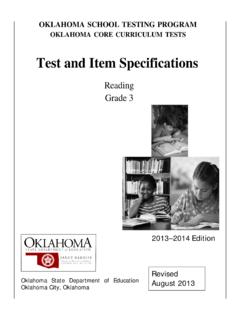Transcription of Performing on Grade Level and Making a Year’s Growth
1 The Optimal Reference Guide: Performing on Grade Level and Making a Year s Growth Muddled Definitions and Expectations Growth Model Series Part III Extraordinary insight into today s education information topics By Glynn D. Ligon Copyright 2009 ESP Solutions Group 1 Table of Contents Introduction ..3 Who Needs Growth Measures Anyway?..4 Growth Models that Predict the Future ..5 Standards versus Norms ..7 Performing on Grade Level ..9 Communicating Assessment Results ..11 Making a Year s Growth ..13 Can We Agree on a Few Concepts?..13 Is it Really Growth ? ..13 Infamous, Briefly Ubiquitous Performance levels and Growth ..17 A Year s Growth in a Year s Time.
2 18 A Gallery of Illustrations of Longitudinal Performance and Current Conclusion ..30 Copyright 2009 ESP Solutions Group 2 Copyright 2009 ESP Solutions Group 3 Introduction I have a long-standing frustration with two concepts that are too often used in misleading ways. Performing on Grade Level and Making a year s Growth are used in so many different contexts and with so many different intents that the audiences trying to understand what they mean are too often left with a misunderstanding of reality. Standards-based, criterion-referenced assessments with their results reported in proficiency levels have helped provide some consensus on Grade - Level performance.
3 However, the frenzy to implement Growth models has muddled the meaning of Making a year s gain. In fact, this pendulum-swinging infatuation with reporting Growth has knocked us back a few decades and revealed that today s statisticians haven t learned the lessons of the past about communicating achievement progress to parents, teachers, and the public. I apologize in advance for Making Growth measurement seem murkier than it is already. If you have read the prior two papers on Growth models, you already know that I think some statisticians promote methodologies that are overly complex, provide minimal added precision, and are incomprehensible to their audiences. I will label those techniques as pedantic models because they ballyhoo sophisticated statistical techniques ( , hierarchical linear models, aka HLM) that demonstrate more the statistician s esoteric mastery of mathematics than an admission of the miniscule, unreliable nature of the differences they tease out of our assessment scores.
4 In other words, the unreliability of data within their models far outweighs the small differences the models squeeze out of the data. That said, this paper reviews some basic concepts about education assessment scores and how we interpret them. Specifically, two oft-used terms are analyzed to ensure we understand how they are defined. Performing on Grade Level Making a year s Growth The hope is that readers will, agree or not with the conclusions, be well informed when they review and support Growth models, and decide how to present the results to decision makers. Copyright 2009 ESP Solutions Group 4 ESP Insight Growth is more for the policy makers than for the teachers.
5 Who Needs Growth Measures Anyway? Growth is more for the policy makers than for the teachers. The point is that what s happening now with a student in the classroom is what a teacher needs to know. Diagnosing current skills and knowledge is the best indicator of what needs to be done for the student today. The measurement error and acceleration/deceleration that are endemic to the world of education assessment make the distant past merely interesting, and the projected future academic. Let me define some of those words within this context. Measurement error is how far off our assessment score may be from the student s true performance Level . Acceleration/deceleration is the natural changes in the pace of learning that each student demonstrates across the Grade levels .
6 Distant past refers to prior assessment scores that are old enough not to influence a teacher s instructional decisions. The distant past may be less than a year back. Projected future is the Growth model s expectation of where a student will perform in a higher Grade Level . Here s that sentence again, now. The measurement error and acceleration/deceleration that are endemic to the world of education assessment make the distant past merely interesting, and the projected future academic. In other words, there is so much error in the measurement and analysis of assessment scores, and students learn faster and slower at different times in their schooling that a student s history of test scores is interesting but not crucial, and a projection of future performance based upon that history intrigues the professors more than the teachers.
7 Copyright 2009 ESP Solutions Group 5 ESP Insight Only when we are wrong do we have any evidence that our interventions made a difference. ESP Insight States with longitudinal databases should follow the accuracy of the predictions from their Growth models. Growth Models that Predict the Future The definitive Growth models are those that report actual Growth . Many, however, even those approved by the Department of Education for measuring adequate yearly progress, attempt to predict future performance. If we required each Growth model to illustrate the fully compounded error range around a student s projected score, the science of projections would quickly become thought of as being similar to the Las Vegas point spread for a football game.
8 Sometimes they are right on, more often than not they are off many times, way off. Pardon a digression into sports betting. With money on the line, the Las Vegas point spread for college football games is reported to predict accurately the winner less than 60% of the time. On average, the point spread is off by 13 points a game. (These very loose statistics come from scanning the numerous websites that track such arcane topics.) Again, here are some definitions for those who don t follow college football point spreads. Point spread is the difference between the two teams final scores. ( , in 2008, the point spread was 7 with Oklahoma the favorite over Texas Oklahoma predicted to win by 7 points.)
9 60% means that out of 10 games, the favored team wins by at least the point spread in 6 and wins by fewer points or loses in 4. 13 points means that on average, the difference between the final point spread and the Las Vegas line is 13 points. ( , in 2008, Texas won 45 to 35, a differential of 17 points from the spread a fairly typical miss by the odds makers.) The analogy to predicting student test scores What if we are accurate only 60% of the time? What if our predicted scores are off by an average of 13 points? With no research to determine reality, these error sizes don t seem unreasonable for Growth models predicting over two or three years. States with longitudinal databases should follow the accuracy of the predictions from their Growth models.
10 I expect we are only a few years away from having those statistics be available and published by several states. My prediction: We ll be disappointed in the accuracy of Growth models predictions when we look at them on a student-by-student basis. Consider this. If our predictions are accurate, then what did we learn from them? Only when we are wrong do we have any evidence that our interventions made a difference. The disappointment I am concerned about is from those false negatives the students we predicted to be proficient, but who were not in the future. Copyright 2009 ESP Solutions Group 6 Now, let s tie this all back to the definition of a year s Growth . When a Growth model makes a prediction, it is typically to answer one of two questions.












